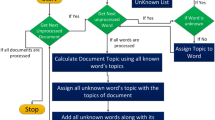Abstract
Bayes risk (BR) decoding methods have been widely investigated in the speech recognition area due to its flexibility and complexity compared with the maximum a posteriori (MAP) method regarding to minimum word error (MWE) optimization. This paper investigates two improved approaches to the BR decoding, aiming at minimizing word error. The novelty of the proposed methods is shown in the explicit optimization of the objective function, the value of which is calculated by an improved forward algorithm on the lattice. However, the result of the first method is obtained by an expectation maximization (EM) like iteration, while the result of the second one is achieved by traversing the confusion network (CN), both of which lead to an optimized objective function value with distinct approaches. Experimental results indicate that the proposed methods result in an error reduction for lattice rescoring, compared with the traditional CN method for lattice rescoring.
Similar content being viewed by others
References
Levenshtein V I. Binary codes capable of correcting deletions, insertions and reversals [J]. Soviet Physics Doklady, 1966, 10(8): 707–710.
Stolcke A, Konig Y, Weintraub M. Explicit word error minimization in n-best list rescoring [C]//Proceedings of the 5th European Conference on Speech Communication and Technology. Rhodes, Greece: ISCA, 1997: 163–166.
Mangu L, Brill E, Stolcke A. Finding consensus in speech recognition: Word error minimization and other applications of confusion networks [J]. Computer Speech and Language, 2000, 14: 373–400.
Goel V, Kumar S, Byrne W J. Minimum bayes-risk automatic speech recognition [J]. Computer Speech and Language, 2000, 14: 115–135.
Wessel F, Schluter R, Ney H. Explicit word error minimization using word hypothesis posterior probabilities [C]//Proceeding of International Conference on Acoustics, Speech, and Signal Processing. Salt Lake City, USA: IEEE, 2001: 33–36.
Goel V, Byrne W J. Segmental minimum bayes-risk decoding for automatic speech recognition [J]. IEEE Transactions on Speech and Audio Processing, 2006, 12: 234–249.
Xu H, Povey D, Zhu J, et al. Minimum hypothesis phone error as a decoding method for speech recognition [C]//Proceedings of INTERSPEECH. Brighton, UK: ISCA, 2009: 76–79.
Povey D, Woodland P C. Minimum phone error and I-smoothing for improved discriminative training [C]//Proceeding of International Conference on Acoustics, Speech, and Signal Processing. Florida, USA: IEEE, 2002: 105–108.
Hoffmeister B, Schluter R, Ney H. Bayes risk approximations using time overlap with an application to system combination [C]// Proceedings of INTERSPEECH. Brighton, UK: ISCA, 2009: 1191–1194.
Heigold G, Macherey W, Schluter R, et al. Minimum exact word error training [C]// Proceedings of Automatic Speech Recognition and Understanding. San Juan, USA: IEEE, 2005: 186–190.
Xu H, Povey D, Mangu L, et al. An improved consensus-like method for minimum Bayes risk decoding and lattice combination [C]//Proceedings of International Conference on Acoustics, Speech, and Signal Processing. Dallas, USA: IEEE, 2010: 4938–4941.
Stolcke A. SRILM — An extensible language modeling toolkit [C]//Proceedings of International Conference on Spoken Language Processing. Denver, USA: ISCA, 2002: 901–904.
Fiscus J G. A post-processing system to yield reduced word error rates: Recognizer output error reduction (ROVER) [C]// Proceedings of Automatic Speech Recognition and Understanding. Santa Barbara, USA: IEEE, 1997: 347–354.
Young S, Evermanna G, Gales M, et al. The HTK book [M]. 3rd ed. Cambridge: Cambridge University, 2006.
Povey D, Kanevsky D, Kingsbury B, et al. Boosted MMI for model and feature-space discriminative training recognition [C]// Proceedings of International Conference on Acoustics, Speech, and Signal Processing. Las Vegas, USA: IEEE, 2008: 4057–4060.
Ortmanns S, Ney H. A word graph algorithm for large vocabulary continuous speech recognition [J]. Computer Speech and Language, 1997, 11: 43–72.
Povey D. Discriminative training for large vocabulary speech recognition [M]. Cambridge: Cambridge University, 2004.
Author information
Authors and Affiliations
Corresponding author
Rights and permissions
About this article
Cite this article
Xu, Hh., Zhu, J. Investigation of improved approaches to bayes risk decoding. J. Shanghai Jiaotong Univ. (Sci.) 16, 524–529 (2011). https://doi.org/10.1007/s12204-011-1189-1
Received:
Published:
Issue Date:
DOI: https://doi.org/10.1007/s12204-011-1189-1




